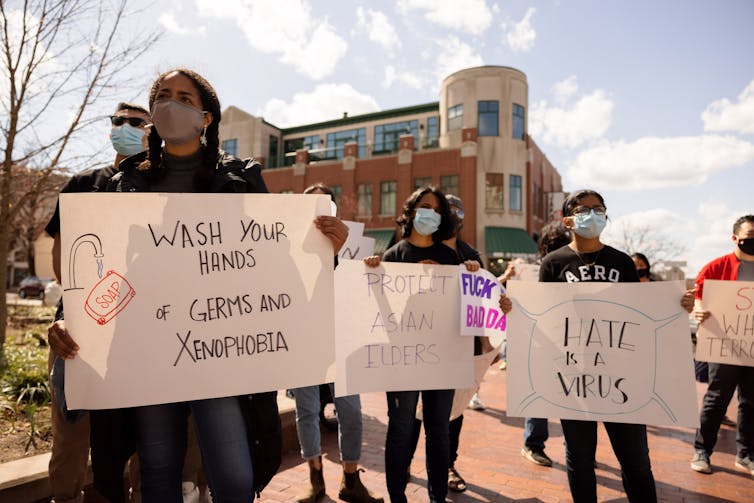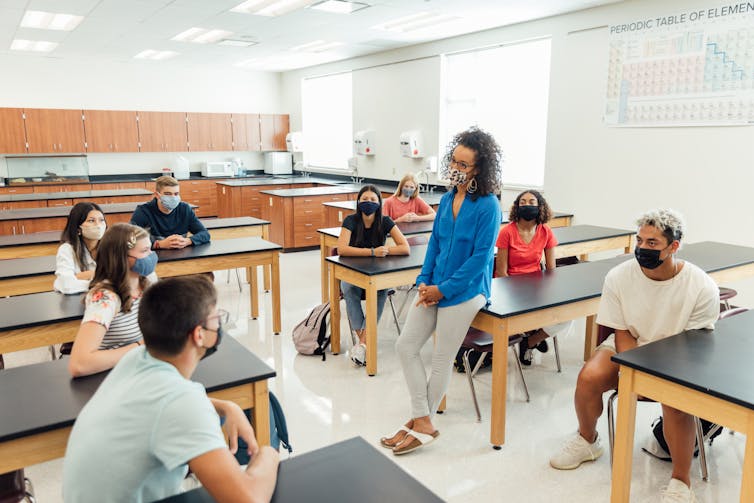Are America's schools safe for Asian Americans?
- Written by Charissa S. L. Cheah, Professor of Psychology, University of Maryland, Baltimore County
The rise in anti-Asian hate crimes[1] during the pandemic has prompted many Asian American parents to enroll their children in remote learning out of concern for their child’s safety at school. Asian American youths are enrolled in remote learning at much higher rates than other racial groups[2]. Federal data[3] show that 78% of Asian American eighth graders attended school virtually in February 2021, whereas just 59% of Black, 59% of Latino and 29% of white students attended school virtually.
Here, three scholars address school safety for Asian American students.
Are American schools dangerous for Asian American students?
Aggie J. Yellow Horse, assistant professor of Asian Pacific American Studies at Arizona State University.
Data show that many Asian American youths have experienced anti-Asian violence in the past year.
Asian Americans have experienced a great deal of racial harassment[4] amid the COVID-19 pandemic. A recent survey found that 1 in 8 Asian Americans[5] reported experiencing anti-Asian hate incidents in 2020. The victims of that harassment aren’t just adults – they include students.
Since the beginning of the pandemic, more than 3,800 hate incidents[6] targeting Asian Americans and Pacific Islanders have been reported to the Stop AAPI Hate National Reporting Center[7]. Among the incidents early in the pandemic, 16% percent of the targets were Asian American youths ages 12-20.
 Anti-Asian hate crimes have been on a steep rise during the pandemic.
Jeremy Hogan/SOPA Images/LightRocket via Getty Images[8]
Anti-Asian hate crimes have been on a steep rise during the pandemic.
Jeremy Hogan/SOPA Images/LightRocket via Getty Images[8]
The majority of the young victims[9], about 80%, reported being bullied or verbally harassed. In over half the incidents, the perpetrator used anti-Asian hate rhetoric. About 1 in 5 hate incidents happened at school.
National trends before the pandemic suggested that Asian American students were already more likely to experience racial discrimination[10], such as race-related name-calling, from their peers at school than other categories of students. About 11% of Asian American students reported being called hate-related words, compared with 6.3% of white students in 2015. A separate study found that bullying and physical violence were less of an issue for Asian American students. Only about 7.3% reported being bullied at school[11] in 2017, compared with 23% of white students.
How common race-based harassment against Asian students is can vary based on different factors, such as where students live, their gender, grades or immigration status. For example, a study from California[12] found that Asian American sixth graders in California reported being bullied and victimized at higher rates than other racial groups.
What are the biggest worries for Asian American youth and parents?
Charissa S. L. Cheah, professor of psychology at the University of Maryland, Baltimore County
Many Asian American parents are worried that their children will be the victims[13] of discrimination once school reopens.
In one survey, nearly 1 in 2 Chinese American parents and 1 in 2 Chinese American youth[16] reported being directly targeted with COVID-19 racial discrimination in person or online. About 4 in 5 of these parents and their children also reported witnessing racism directed at someone else of their own race either online or in person.
Despite their concerns, some parents may avoid talking to their children about anti-Asian racism to avoid scaring them while they are at school. Even if parents want to have the “race talk”[17] with their children, many struggle with how to talk to their children[18] about the potential racism they might encounter. Some parents may not have been taught these lessons while growing up and are grappling with how to make sense of these experiences[19].
Anti-Asian racism is also associated with greater depressive symptoms and anxiety[20] in Chinese American parents and their children. A majority of Americans blame China[21] for its mishandling of the coronavirus outbreak. Researchers have found that even thinking that one’s racial or ethnic group is viewed by the general public as a threat to the health of Americans is linked to poorer mental health in both Chinese American parents and youths[22].
Asian Americans are less likely[23] than non-Hispanic white Americans to seek mental health help. This is due in part to perceived stigma, language barriers and lack of mental health providers of the same ethnicity. These disparities are even greater for Asian American families with fewer financial resources.
 Elderly Asian Americans are at a higher risk of being hospitalized or dying from COVID-19.
Ringo Chiu/AFP via Getty Images[24]
Elderly Asian Americans are at a higher risk of being hospitalized or dying from COVID-19.
Ringo Chiu/AFP via Getty Images[24]
Some Asian American parents have also expressed concerns about the ability of schools to maintain appropriate COVID-19-related health and safety measures. They are worried about the health risks that children exposed to others at school[25] might bring home. Asians Americans are more likely to live in a multigenerational household[26], in which older adults might be at a higher health risk.
Even if parents choose to keep their children home because of one or several of these concerns, they are getting the message that in-person education is superior to virtual education[27]. Being out of physical school could cause Asian Americans to miss out on these opportunities and resources even more. Also, due to the “model minority myth[28],” which characterizes Asian Americans as successful, the needs of this very diverse group[29], including a large number of immigrant and refugee Asian families[30] in the U.S., are often overlooked. With 30% of Asian Americans reporting limited English proficiency[31], these families are more difficult to reach. The fears of being harassed also make some parents reluctant to access educational materials or free meals[32] or even reach out to teachers or counselors for help.
What can schools do to reduce threats to Asian American students?
Kevin Gee, an associate professor in the school of education at the University of California Davis
Helping students build strong and supportive relationships with each other can reduce their physical victimization[33] and buffer the negative effects[34] of discrimination Asian Americans face.
Schools can also create supportive environments[35] by implementing a range of evidence-based approaches[36], such as building teachers’ cultural knowledge and strengthening teacher-student relationships. Activities like engaging students in class discussions about bullying have been shown[37] to reduce bullying.
 Class discussions around the harms of bullying in schools can prevent harassment toward Asian American students.
RichVintage/E+via Getty Images[38]
Class discussions around the harms of bullying in schools can prevent harassment toward Asian American students.
RichVintage/E+via Getty Images[38]
Alongside initiatives to build supportive environments, schools should also consider partnering with parents. Directly engaging Asian American parents in anti-bullying initiatives can help reduce victimization[39]. For example, schools can collaborate with parents to craft disciplinary policies on bullying. Schools can also hold workshops to teach parents how to handle and prevent bullying.
In order to reduce threats and eradicate harm, I believe schools will need to consider whether they are doing enough to protect Asian American youth. One landmark case[40] underscores this. In the aftermath of violent attacks on Asian American students at South Philadelphia High School in 2009, a Department of Justice investigation revealed that the school district was “deliberately indifferent[41]” to harassment against Asian students that fueled the attacks.
A key takeaway: Harms against Asian American students can be systemic and require broader structural solutions. When South Philadelphia High School began to do more to promote multicultural awareness and improved systems to report and investigate harassment, the school saw fewer violent incidents[42].
To make Asian American youth feel safe and protected, schools need to track, report and respond to incidents of hate against Asian Americans, especially among Asian American ethnic subgroups[43]. Subgroup data, often lacking on Asian Americans[44], can be a powerful tool in revealing potential disparities and highlighting groups that schools need to target for support.
I believe schools also need to invest in longer-term systemic changes such as including a more complete history of Asian Americans in U.S. social studies curricula[45].
[Deep knowledge, daily. Sign up for The Conversation’s newsletter[46].]
References
- ^ rise in anti-Asian hate crimes (secureservercdn.net)
- ^ much higher rates than other racial groups (www.usnews.com)
- ^ Federal data (ies.ed.gov)
- ^ racial harassment (www.adl.org)
- ^ 1 in 8 Asian Americans (science.sciencemag.org)
- ^ more than 3,800 hate incidents (secureservercdn.net)
- ^ Stop AAPI Hate National Reporting Center (stopaapihate.org)
- ^ Jeremy Hogan/SOPA Images/LightRocket via Getty Images (www.gettyimages.com)
- ^ majority of the young victims (secureservercdn.net)
- ^ racial discrimination (doi.org)
- ^ reported being bullied at school (nces.ed.gov)
- ^ a study from California (pubmed.ncbi.nlm.nih.gov)
- ^ worried that their children will be the victims (www.pbs.org)
- ^ NPR (www.npr.org)
- ^ (download) (cdn.theconversation.com)
- ^ 1 in 2 Chinese American parents and 1 in 2 Chinese American youth (pediatrics.aappublications.org)
- ^ want to have the “race talk” (www.nytimes.com)
- ^ struggle with how to talk to their children (doi.org)
- ^ make sense of these experiences (www.theatlantic.com)
- ^ greater depressive symptoms and anxiety (doi.org)
- ^ Americans blame China (www.pewresearch.org)
- ^ poorer mental health in both Chinese American parents and youths (doi.org)
- ^ less likely (doi.org)
- ^ Ringo Chiu/AFP via Getty Images (www.gettyimages.com)
- ^ health risks that children exposed to others at school (www.washingtonpost.com)
- ^ more likely to live in a multigenerational household (www.pewresearch.org)
- ^ getting the message that in-person education is superior to virtual education (www.aappublications.org)
- ^ model minority myth (www.doi.org)
- ^ very diverse group (www.pewresearch.org)
- ^ immigrant and refugee Asian families (www.washingtonpost.com)
- ^ limited English proficiency (aapidata.com)
- ^ reluctant to access educational materials or free meals (www.washingtonpost.com)
- ^ reduce their physical victimization (doi.org)
- ^ buffer the negative effects (doi.org)
- ^ supportive environments (www.apa.org)
- ^ evidence-based approaches (www.air.org)
- ^ have been shown (doi.org)
- ^ RichVintage/E+via Getty Images (www.gettyimages.com)
- ^ reduce victimization (doi.org)
- ^ landmark case (www.justice.gov)
- ^ deliberately indifferent (www.justice.gov)
- ^ fewer violent incidents (whyy.org)
- ^ Asian American ethnic subgroups (aapidata.com)
- ^ often lacking on Asian Americans (aapidata.com)
- ^ a more complete history of Asian Americans in U.S. social studies curricula (time.com)
- ^ Sign up for The Conversation’s newsletter (theconversation.com)
Authors: Charissa S. L. Cheah, Professor of Psychology, University of Maryland, Baltimore County
Read more https://theconversation.com/are-americas-schools-safe-for-asian-americans-157956

